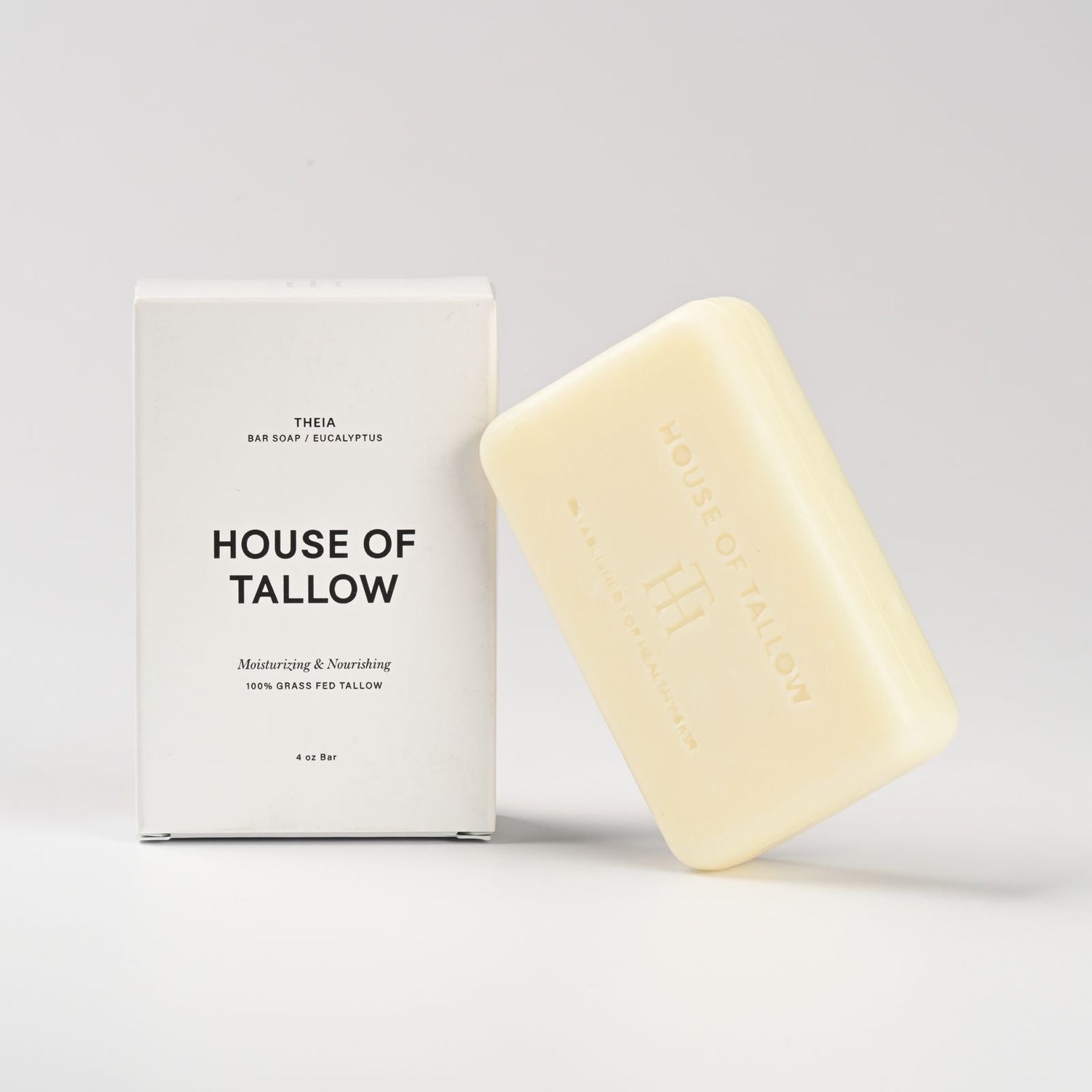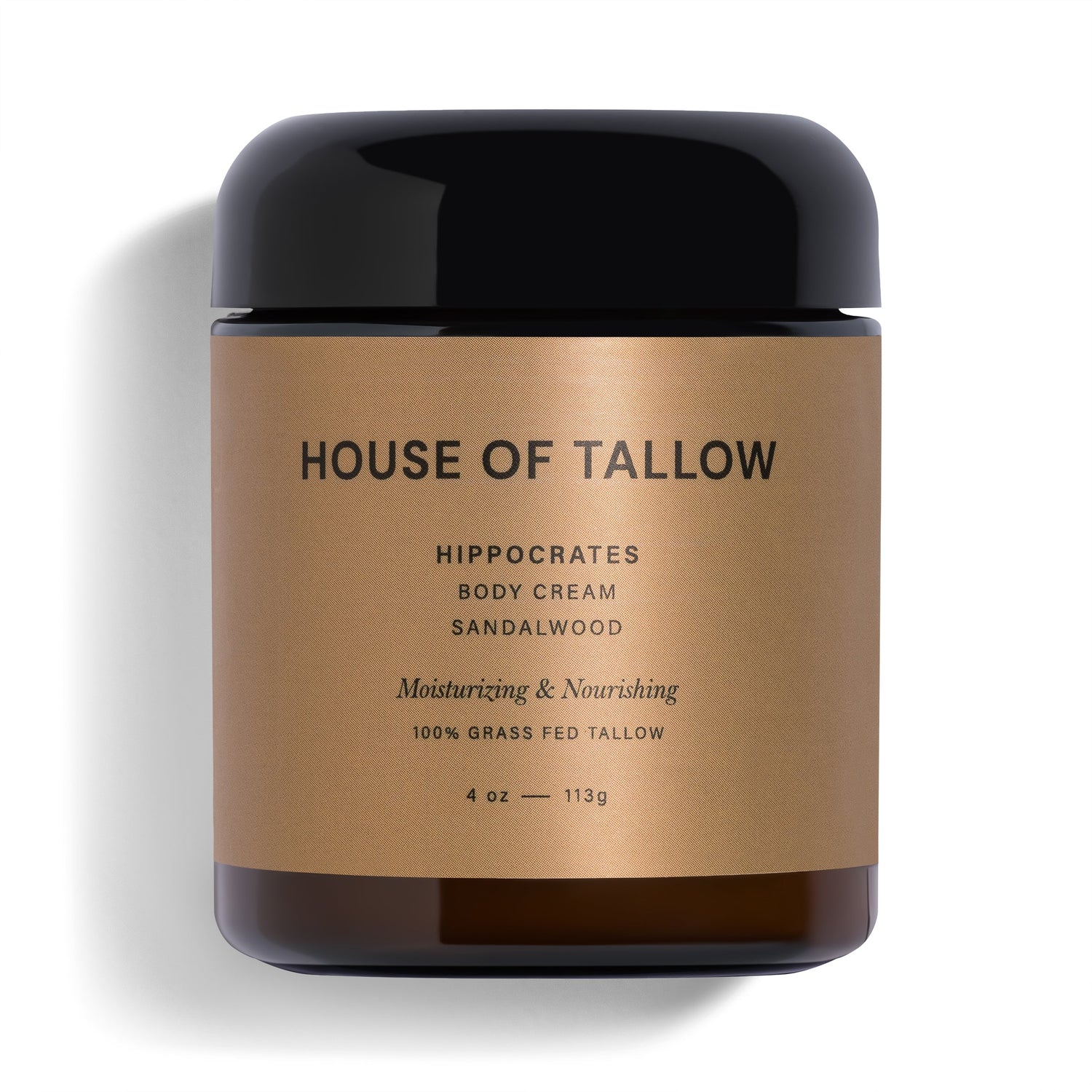Tallow-based skincare has a smaller carbon footprint compared to synthetic products. Here's why:
- Tallow products (made from animal fat) are simpler to produce, use fewer resources, and emit 0.8 kg CO2e per 100ml.
- Synthetic skincare relies on petrochemicals, complex processes, and emits 1.5 kg CO2e per 100ml. It also consumes 3x more water and 2.5x more energy.
- Tallow biodegrades naturally, while synthetic ingredients like silicones take centuries to break down.
- Regenerative farming for tallow can sequester 3.5 tons of carbon per hectare annually, offsetting emissions.
Quick Comparison
| Aspect | Tallow-Based Products | Synthetic Products |
|---|---|---|
| Ingredients | 3-5 natural ingredients | 20+ synthetic ingredients |
| Carbon Emissions | 0.8 kg CO2e per 100ml | 1.5 kg CO2e per 100ml |
| Water Use | Minimal (rain-fed grazing) | 83,000 liters per ton |
| Energy Use | Low | 2.5x higher |
| Decomposition | Biodegrades in weeks | Takes centuries |
| Land Impact | Supports soil health | Linked to industrialization |
Switching to tallow-based skincare can reduce your skincare-related carbon footprint by up to 60%. Keep reading for a detailed breakdown of production, resource use, and disposal impacts.
Carbon Output Through Product Life
Getting Raw Materials
The process of sourcing raw materials shows clear differences:
Synthetic skincare ingredients depend largely on petrochemical extraction. For instance, producing mineral oil generates around 5 kg of CO2 for every kilogram of product[2].
On the other hand, grass-fed cattle farming, used for tallow production, can help offset carbon emissions through carbon sequestration. Research indicates these farming practices can capture about 3.5 tons of carbon per hectare annually[3]. Companies like House of Tallow exclusively source tallow from grass-fed cattle farms, aligning their practices with regenerative farming methods and their environmental goals.
These sourcing methods significantly influence the environmental footprint of manufacturing.
Making the Products
The production stage highlights notable differences:
| Production Aspect | Tallow-Based Products | Synthetic Products |
|---|---|---|
| Process Complexity | Simple rendering | Multi-stage chemical synthesis |
Synthetic skincare production involves energy-heavy chemical processes, with facilities consuming between 50-100 kWh per kilogram of product[4], often powered by fossil fuels.
Disposal Effects
The environmental impact after use also varies greatly:
Tallow-based skincare products break down naturally within weeks or months[3], fitting well with a circular economy approach. In contrast, synthetic ingredients like silicones can take hundreds of years to decompose[4].
Additionally, tallow byproducts biodegrade without intervention, while synthetic manufacturing waste often requires industrial-level processing to manage its disposal.
Related video from YouTube
Resource Use Comparison
When it comes to resource efficiency, these production methods take different paths.
Water and Land Requirements
The water usage between tallow-based and synthetic skincare production varies greatly. Grass-fed cattle farming for tallow mostly depends on rainwater and natural water sources, while synthetic production often involves water-heavy industrial processes. For example, synthetic production has a water footprint of 83,000 liters per ton[1][3], partly due to the energy needed for water treatment.
Land use also highlights some key differences:
| Resource Type | Tallow Production | Synthetic Production |
|---|---|---|
| Land Usage | 2.5-5 hectares per cow | 100-500 hectares per facility |
| Land Impact | Supports soil carbon storage | Linked to industrial intensification |
Although tallow production requires more land per cow, regenerative grazing practices contribute to soil health and carbon storage. House of Tallow works with regenerative partner farms to emphasize these benefits[6].
Waste Management
The way waste is handled further sets these methods apart. Tallow-based skincare repurposes byproducts from the meat industry, creating a circular use of materials. This is a sharp contrast to synthetic production, which comes with its own challenges:
"Synthetic skincare manufacturing produces 20-30% waste materials, some requiring hazardous disposal[8]."
Tallow products also stand out for their efficiency. A 100g tallow cream can last as long as 300-500ml of synthetic lotion[5], cutting down on packaging and transportation needs. This makes tallow a more resource-efficient option overall.
sbb-itb-a1b9fc0
Reducing Carbon Impact
Both industries are stepping up their efforts to lower carbon emissions, building on earlier improvements in resource efficiency.
Tallow Production Methods
Tallow producers are leveraging its natural lifecycle benefits with new methods. These include solar-powered rendering facilities and hyper-local supply chains, which have helped some producers cut supply chain emissions by as much as 90% [5][6].
Synthetic Production Updates
The synthetic skincare sector, traditionally slower in this area, is making strides with green chemistry practices. For example, L'Oréal has reduced its 2023 emissions by 12% and is aiming for 95% renewable ingredients by 2030 [9]. This aligns with the industry's broader goal of a 60% emissions reduction.
Key improvements in synthetic production include:
- Energy-efficient equipment: New machinery significantly lowers energy use.
- Simplified ingredient lists: Cutting down on ingredients reduces processing steps by up to 30% [3].
- Emission trapping systems: These systems help capture and reduce facility emissions.
Both industries are embracing new technologies to further cut emissions. The shared goal is to adopt sustainable practices that balance environmental responsibility with maintaining product quality.
Conclusion
Looking at production and disposal patterns, tallow stands out with clear benefits when it comes to carbon emissions.
Key Insights
Lifecycle analysis highlights tallow's lower carbon footprint:
- Tallow-based skincare is created as a byproduct of the meat industry, meaning it requires little to no extra resources [2].
- On the other hand, synthetic skincare relies on petroleum-based ingredients [7] and involves energy-intensive chemical processes [2][3], which lead to significantly higher emissions.
Considering Environmental Impact
The environmental footprint of skincare goes beyond how products are made. Synthetic skincare manufacturing contributes to a staggering 120 billion non-recyclable packaging units each year [3]. In contrast, tallow-based products often use simpler, more eco-friendly packaging.
Although both sectors are evolving, tallow’s biodegradable nature and its integration into existing industries make it a more appealing option for consumers focused on reducing their climate impact.
FAQs
Is tallow bad for the environment?
Tallow-based skincare products tend to have a smaller environmental footprint because tallow is a byproduct of the meat industry. When it comes from grass-fed cattle operations, these farms can capture up to 3.5 tons of carbon per hectare each year[5]. This ties back to the benefits of regenerative farming practices mentioned earlier.
Unlike synthetic ingredients that can linger in the environment, tallow naturally decomposes without causing long-term issues[3]. Plus, its production involves fewer processing steps, making it a more eco-friendly option for skincare[2].




